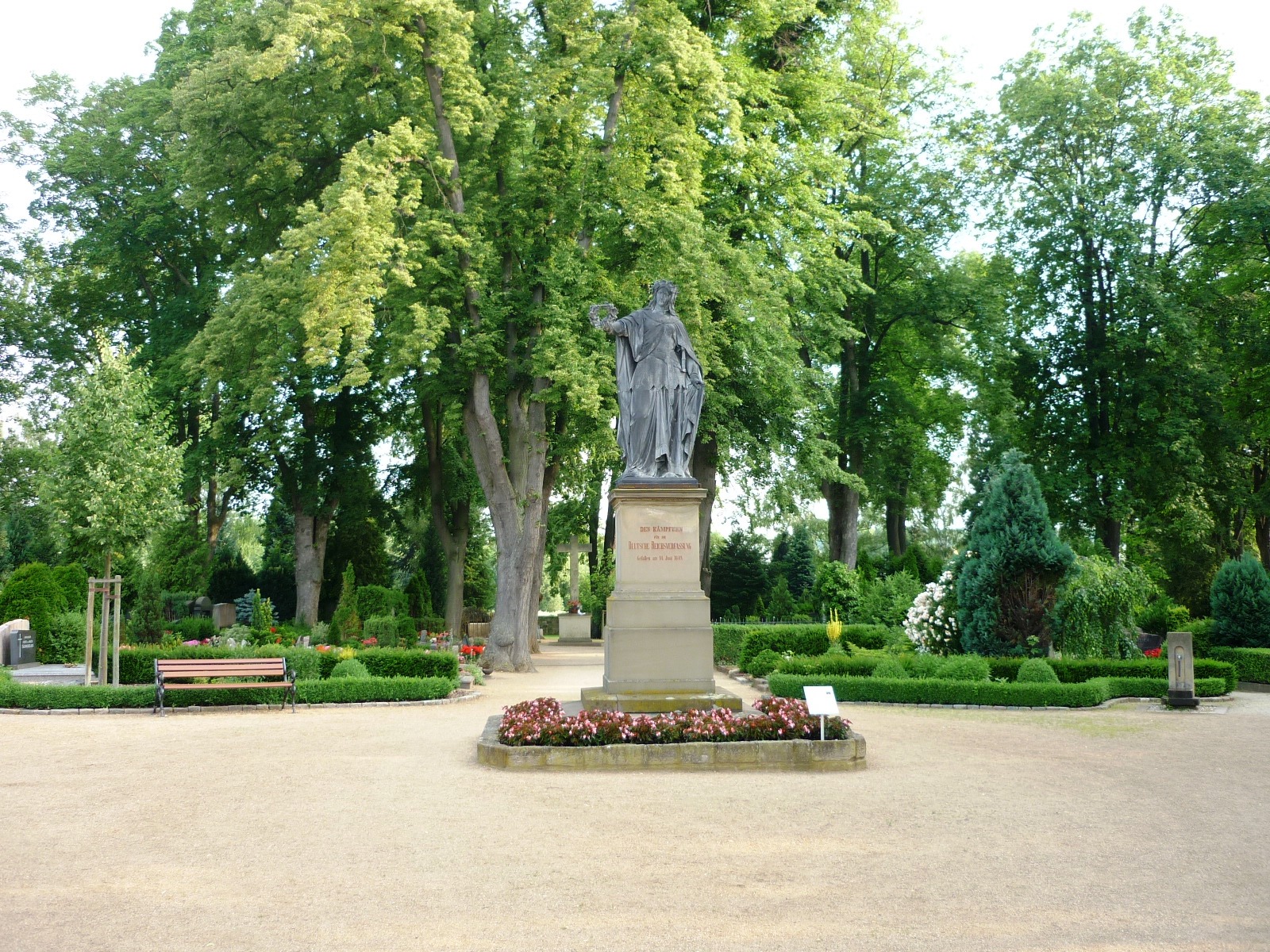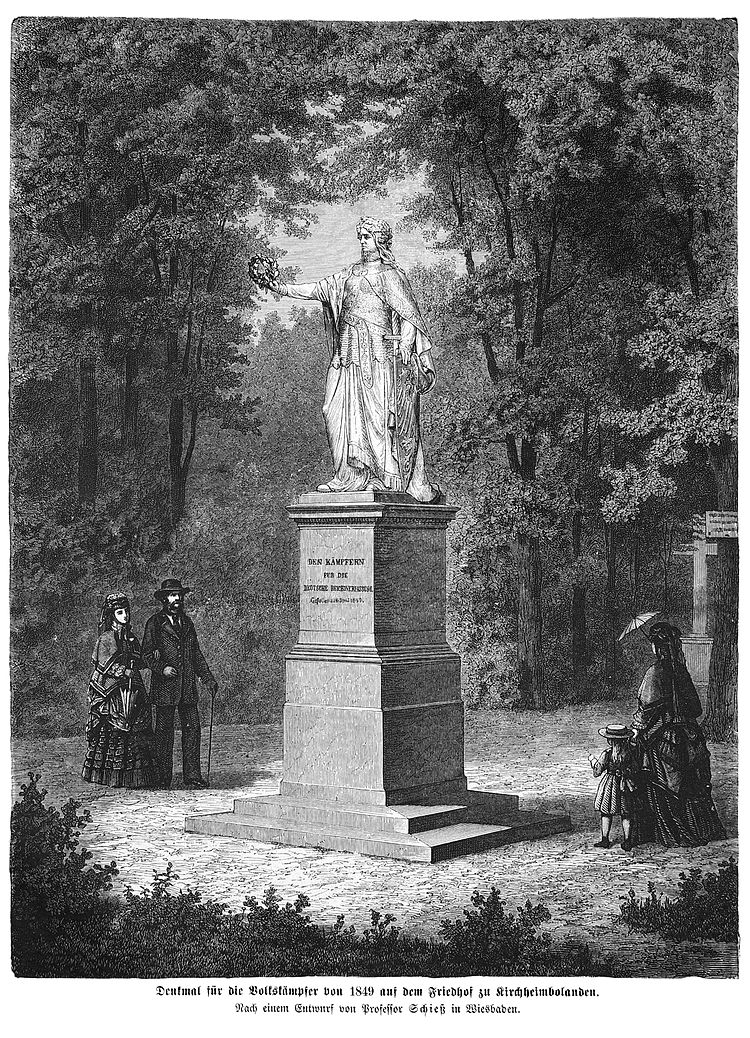Mourning Germania
Imperial culture of remembrance
The culture of remembrance is by no means an unambiguous collective term for very different approaches to historical dates and events. Three aspects in particular need to be considered: historical remembrance must allow for a plurality of perspectives – this includes ensuring critical debate – and should encourage people who have become victims to “reclaim their subject status” from an affective point of view.
The imperial culture of remembrance, on the other hand, set different standards. The model was determined by patriotic hero and veteran motifs. “With God for King and Fatherland” and “Through blood and iron” defined historical and political thinking.
Three memorial themes in particular provided an illustration of this: Kaiser Wilhelm I, Otto von Bismarck and the War of 1870/71.
Wilhelm I was thus commemorated on the Schiller Grove [Standort 15] and the German-French War on the “Freie Platz” in front of the Catholic Church of St. Peter [Standort 23]. A special tribute to Bismarck, on the other hand, was left to nearby Dannenfels with the “Eagle Arch” inaugurated in 1883.
Monuments with a direct reference to the revolution of 1848/49, on the other hand, were only erected sporadically: in Kirchheimbolanden (1872), Annweiler (1874), Mannheim (also 1874), Flensburg (1888) and Frankfurt a. M. (1903). All of them were designed from the point of view of “classifying” the revolutionary events in the founding myth of 1871, but they also provided individual space for a plurality of perspectives and the admission of critical debate and the affective idea of sacrifice.
How decisive this commemoration of sacrifice was for the erection of the Kirchheimbolander Freischaren monument is demonstrated by its financing. A “Mainz Committee” organized collections and donations – including former irregulars who had emigrated to the USA. A “Kirchheimbolander Committee” also contributed.

Monument theme 1848/49
Monuments should create and pass on memories. But what is worth remembering about the revolution of 1848/49: the imperial constitution and the subsequent “imperial constitution campaign” or rather other emphases?
The first monument to this effect in Germany was erected in 1850 in Berlin’s Invaliden-Park, the columned monument of the National War Memorial, crowned by a Prussian eagle, in memory of the brothers and comrades in arms who fell faithfully to their duty for king and country in 1848 and 1849. The focus was thus placed entirely on the military defeat of the revolution.
Pre-revolutionary memorials, on the other hand, only followed with a time lag in the German Empire, starting in 1872 with Kirchheimbolanden. It was not until the foundation of the German Empire in 1871 that monuments were erected to the pioneers of German unity – as the Frankfurt “Unity Monument” on St. Paul’s Square to the side of St. Paul’s Church shows.
In terms of design, the Mannheim and Frankfurt memorials are obelisks, while the ones in Kirchheimbolanden and Annweiler are “Germania” figures on ashlar pedestals.
The Kirchheimbolander monument was artistically designed by Hermann Schies (1836-99), professor at the Wiesbaden School of Architecture and Arts and Crafts. He produced the model of “Germania”, which was then realized in the galvanoplastic workshop Kreß von Kressenstein in Frankfurt am Main. The casting was carried out by the A. Kastner art foundry in Berlin. And the pedestal was supplied by the Kirchheimboland sculptor Michael Schuler.
“Die Gartenlaube”, the leading weekly newspaper of the important genre of “illustrated family papers” in the imperial era, depicted the Kirchheimbolander “Germania” and stated: “Everyone has worked to their credit, because the monument is one of the most beautiful in Germany.

Symbolic figure “Germania
The Kirchheimbolander Freischaren monument is to be understood as an embodiment of imperial historical and political thought through the personification of “Germania”.
It is worth taking a look at “Meyers Konversationslexikon”, which was aimed in particular at the liberal bourgeoisie. In the 1895 edition, under the keyword “Germania”, it says: Roman name for Germany; in poetry and the visual arts, the personification of the concept of the countries united into a political whole [deutschen]; [im preußisch-deutschen Kaiserreich in Sieges- und Kriegsdenkmälern häufig und als] connection of the old battle maiden [Walküre] with the German mother symbolizing the all-encompassing fatherland.
“Meyers Lexikon” is thus entirely dedicated to the idea of the national state. But even before the foundation of the German Empire in 1871, the figure of “Germania” played a national symbolic role, for example in the 1850/60s at the numerous shooting, singing and gymnastics festivals. The “Germania” was thus at the same time the integrating figure of a bourgeois understanding of the world in a Germany that was still unfinished nationally.
It could therefore also be used without major problems for the memorial dedicated in 1872 to the fighters for the German imperial constitution who fell on June 14, 1849.
With a figure height of 2.60 meters and a total height of 5.55 meters, the “Mourning Germania” in Kirchheimbolanden gives the Freischarendenkmal its character. However, the fact that she is not depicted as “Victorious Germania” as on the Niederwald monument is due to the events of June 14, 1849 in the castle garden [Standort 48].
The unveiling of the “Mourning Germania”
The unveiling ceremony of the Kirchheimboland “Germania” was a much-noticed media topic in 1872. Numerous newspapers presented the monument in detail, such as the “Gartenlaube” published in Leipzig, or reported on the unveiling ceremony on June 16, 1872, with the “Frankfurter Zeitung” covering the celebrations particularly extensively. It sent a special editor to cover the event.
Even his description of the monument gives a sense of the ambivalence in which the “Mourning Germania” is to be seen:
On a pedestal about ten feet high stands Germania, about eight feet tall in bronze, wearing an undergarment, striped armor, a sword belt and a cloak thrown over her shoulder: the shield with the German imperial eagle leans against her left side and her left hand rests on the sword. Her right hand is outstretched and carries an oak wreath, which she is about to lay on the graves of the fallen below. Her face shows the expression of deepest sorrow, and the whole figure is imprinted with an attitude of great pain alongside the calm dignity of renunciation. In this way, the artist has succeeded in depicting not only that time, but also the entire epoch since then up to the present day in a single figure. The hand on the sword points to the path that was taken to preserve freedom at that time, the hand with the wreath adorns with the highest praise the fighters who gave their lives for their right, and the face and posture express the noble and yet undaunted resignation that currently weighs on the real Mother Germania.
Kirchheimbolanden therefore made a fitting appearance at the unveiling ceremony:
All the houses were decorated with flowers, wreaths and flags, green foliage was strewn across the streets, and fresh flowers were placed to the side, so that one almost thought one was walking through a forest. All the alleys, however, and especially the public places, were crowded and teeming with clean and cheerful people. It was, of course, a celebration of the dead, but if the memory of the dead was honored, shouldn’t the living also have their right?
The dead were honored with a black flag in the nearby castle garden. And the living? Like all festivals, according to the Frankfurter Zeitung,
generally had the character of entertainment, spectacle and enjoyment for the masses. But where, and this happened frequently and emphatically enough, a political thought was able to break through, this thought was a liberal, a popular, a democratic one. […] There was no jubilation over the new German Reich, no praise of the imperial constitution, no stirring up of confessional strife and ecclesiastical disputes, no telegram to Prince Bismarck, no high praise for the emperor. What was the point of all this, what was the point of cheering the Kaiser on this day?
After all, it was Kaiser Wilhelm I who, as crown prince, had led the Prussian troops as commander-in-chief on June 14, 1849. The “day of celebration” could hardly have been more ambivalent.
From a police point of view, however, everything remained “calm”. The “Frankfurter Zeitung” therefore concluded its report from Kirchheimbolanden in an imperial pathetic tone:
The attitude of the population was exemplary. Although there were perhaps ten thousand festival-goers in and out of the city, there were no disturbances, no accidents, no excesses. I only saw two police officers in the afternoon, sitting in the beer garden and enjoying a beer with the locals. The people didn’t need to be watched, they watched themselves. That’s why the celebration had a self-confident, dignified character despite the socially cheerful tone. It was a day of honor for the town and all its guests, and the day of June 16, 1872 in Kirchheimbolanden will be an unforgettable one for me and many other visitors to the festival.